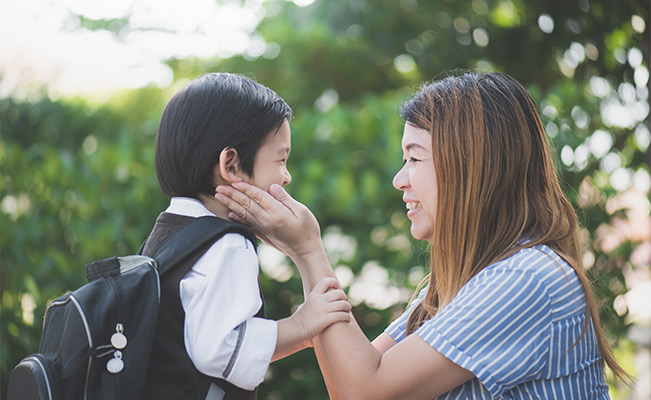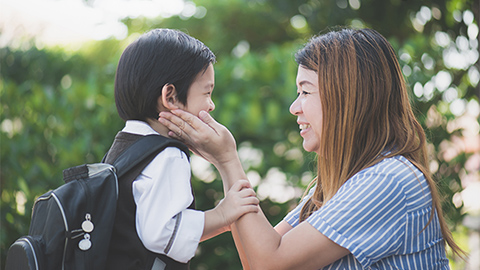
Child discipline is an important part of parenting that involves teaching your child right from wrong, discouraging undesirable behaviors and promoting behavior in accordance with social rules. Unfortunately, it's also often linked to punishment and control meted out via corporal punishment (spanking, for instance). Much controversy surrounds child discipline. As we learn more about child development -- and the effect parenting has on child behavior -- one thing is clear: Discipline should focus on imparting knowledge and skill to the child1. We want our children to be able to regulate their own behavior, internalize rules, and act appropriately in any situation. All these aspects play a crucial role in how to discipline a child.
According to experts, child discipline should be executed with the following in mind:
- It should be given by the parent or guardian who has an “affective relationship” with the child. This is the parent who most satisfies the child’s need for emotional interaction such as warmth and support2.
- Discipline should be consistently delivered right after the behavior that needs to be changed.
- It should be developmentally and temperamentally appropriate. Keep your child’s age and maturity in mind and give discipline that he or she will understand.
- Ultimately, your actions should lead to self-discipline1.
6 Ways to Encourage Positive Child Discipline
Positive discipline is a method that parents are encouraged to use in answering the question of ‘how to discipline a child’ . Here are some tips to practice child discipline without negative feelings.
Positive Child Discipline Tip #1: Be Your Child's Model
Correct behavior calmly by using words and set an example by doing the right action. This is an essential aspect in how to discipline a child.
Positive Child Discipline Tip #2: Set Clear Rules and Explain the Rationale Behind Them
Children are more likely to follow child discipline rules that they understand. Explain the consequences of failure to comply as well. For instance, make sure to tell your child that if they hit their brother with their toy, you will take it away from them. Follow through when they misbehave and do not give in only after a short period of time as part of your regime of how to discipline a child.
Positive Child Discipline Tip #3: Listen to Their Side
Allow your child to feel heard and only then should you try and solve whatever problem may have arisen with the appropriate child discipline methods . Watch out for verbal and non-verbal cues that signal emotions or behaviors. Applying empathy and understanding where they are coming from will also give an insight as to why they displayed such behavior.
Positive Child Discipline Tip #4: Pay Attention to Your Child
If you’re still wondering how to discipline a child, an effective tool in child discipline is giving attention to your child to reinforce the right behaviors. If your child is displaying good behavior, make sure to notice it by giving praise or, for example, by thanking them for doing the chores without being told. Give praise where praise is due. Conversely, ignoring bad behavior is just as effective -- just make sure that the action you are ignoring does not pose any danger to others around the child.
Positive Child Discipline Tip #5: Getting Your Child Ready for Social Experiences
Prepare your child for social situations where they may potentially have trouble behaving properly -- at the pediatrician’s office, for example, or on the first day of school, or at birthday parties. Tell them what they can expect to happen and the proper behavior in such situations. In cases where the child does misbehave, practice positive child discipline by redirecting bad behavior with other activities like coloring books. At times, kids misbehave because they don't know what else to do.
Positive Child Discipline Tip #6: Time-Outs
Time-outs are another technique in the parental child discipline armory. It can be effective in some cases, as it removes the child from the situation and reminds them that they did something wrong or unacceptable. It also helps them learn to manage themselves when you tell them to come back once they feel ready and in control3. Giving them ample time and space will help them think through the situation. This tip can surely help you in your plan of how to discipline a child .
The Key Takeaway of Child Discipline
The ultimate goal of child discipline is to teach the child to take responsibility for their own actions4. In order to do this successfully, you as a parent must be aware of your own discipline style. Are you permissive, aggressive or assertive?
A permissive style focuses more on your role as a nurturer, and avoiding child discipline issues . This parenting style may result in teaching your child to not respect you or to not be accountable for their actions. They may learn that there are no limits when it comes to their behavior.
An aggressive parenting style is the other extreme, mostly zoning in on strict child discipline. This may result in an impaired relationship with your child, damaged self-esteem issues and a possibility of rebellion in later life.
The assertive style, the median of the two, finds you as a parent able to listen yet standing firm on rules. It ultimately meets both the needs of parents and children’s needs5.
Do remember that child discipline, especially in young ones, depends on their developmental level. Match your discipline methods with your child's ability to learn responsibility and self-control4. You should now be well equipped with all the necessary tools in how to discipline a child. All the best!
Be part of Club Mama today to unlock a world of privileges and benefits which include free samples, exclusive vouchers, promotions, expert advice and many more!
References:
1 Effective discipline for children. https://www.ncbi.nlm.nih.gov/pmc/articles/PMC2719514/. Accessed 3 Sept. 2020
2 Toward a Life Span Theory of Close Relationships: The Affective Relationships Model. https://www.karger.com/Article/PDF/83215. Accessed 3 Sept. 2020
3 What’s the Best Way to Discipline My Child? https://www.healthychildren.org/English/family-life/family-dynamics/com…. Accessed 3 Sept. 2020
4 Discipline and children. https://www.betterhealth.vic.gov.au/health/HealthyLiving/discipline-and…. Accessed 3 Sept. 2020
5 The Most Effective Parenting Style for Discipline that Works. https://centerforparentingeducation.org/library-of-articles/discipline-…. Accessed 3 Sept. 2020

